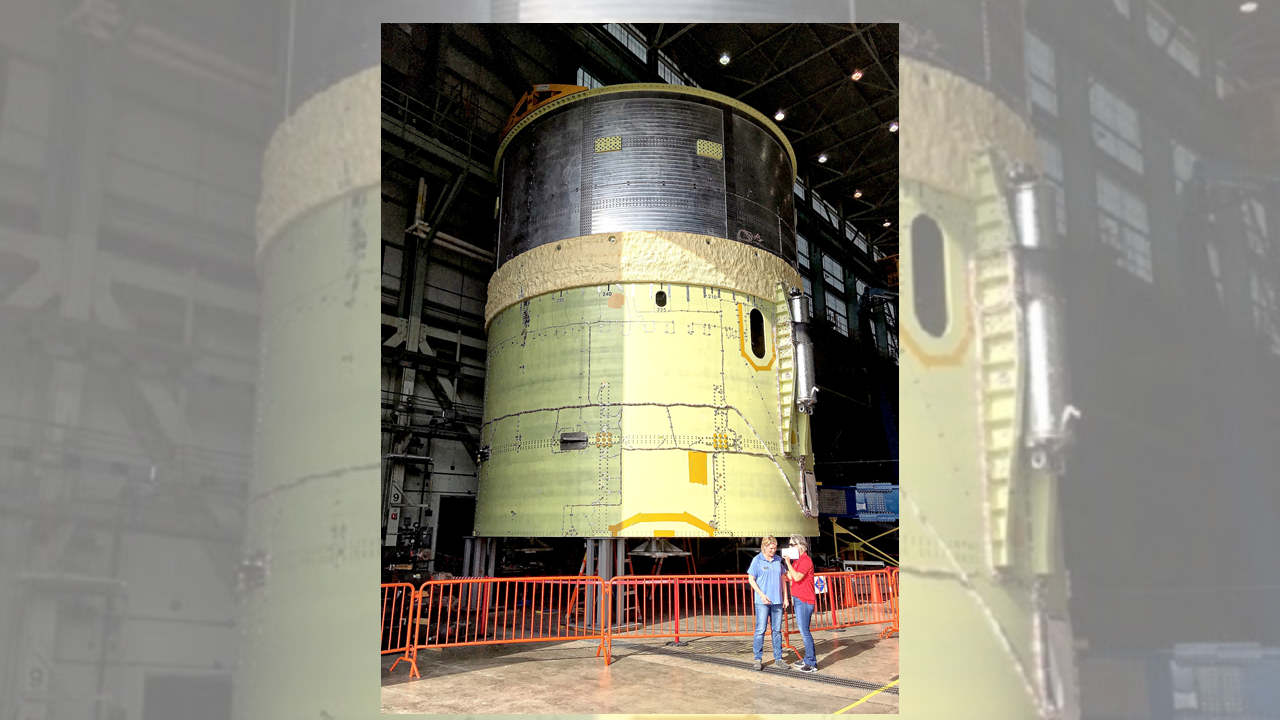NASA spokespersons, in the foreground, show how large the engine section and tank simulator are.
HUNTSVILLE – Last week, a barge arrived at Redstone Arsenal, carrying what NASA calls a “test article” for its Space Launch System (SLS) that will help pave the way for manned missions to Mars. The Tribune was among a small group of outlets that attended a press briefing and tour of the project and its facility, Marshall Space Flight Center’s historic Building 4619, that has been used to test rocket components since the Apollo program in the 1960s.
The test article contains the core stage engine section (yellow-green in photos), that will hold the SLS’ four main engines; atop the engine section sits a simulator (silver in photos) that represents a portion of the liquid hydrogen tank that will sit above the engines on the SLS. The whole thing will be mounted in a test stand, where hydraulic equipment will push and pull on it in ways specifically designed to simulate the stresses of takeoff. Basically, they will make sure that the force of liftoff does not tear the rocket apart.
While numerous small projects have gone on, the test article is the first major piece of space exploration hardware to come to Redstone for testing since the space shuttle program.
Test Project Manager Robert Bobo said, “The guys are somewhat in awe that we finally have something tangible that we can touch and feel. It’s gotten off the paper- no longer drawings and charts and schedules, but we have hardware that is designed and built to fly, here at Marshall.”
NASA spokesperson Heather Haney added, “We haven’t had anything this big here since the space shuttle. This is huge; this is getting us on to our mission for NASA, making sure that we’re safe to fly, meeting that mission success. The mission for NASA is to go beyond the moon, further than we’ve ever been: to Mars, to wherever our mission requires. It’s the most powerful and capable rocket we’ve built since the shuttle, so it will be able to take us where they want us to go.”
Engineers and technicians will spend the next four months setting up the test article in its stand and closing the stand around it, before actual testing begins. Over time, three more test articles will arrive at Marshall: a full-size liquid hydrogen tank, liquid oxygen tank, and intertank assembly to connect the two tanks; with the engine section, they comprise the majority of the SLS core stage, the largest rocket stage in the world.
Project impact
It’s not all rocket science; it’s also money and jobs. A statement from NASA said:
“Marshall directly employs nearly 2,500 civil service workers across the nation. Moreover, for every civil servant employed, approximately 14.2 additional jobs are supported throughout the economy. These jobs come in the form of contractors and also the dentists, retail workers, school teachers, and others necessary to support the employment base. Additionally, those employees spend money in their community, thereby generating significant tax revenues for area economies. Throughout the United States, Marshall supports nearly 38,000 jobs and generates a total economic output of nearly $7 billion along with $830 million in federal, state and local tax revenues.”
Large components like the test article have to come from large operations, but large components are made up of lots of small components. More than half of Marshall’s contracts are sourced to Alabama suppliers, sometimes even small family-owned fabrication shops in places like Russellville and Guntersville. Most everyone around the Cullman area has a friend or neighbor who commutes to work at Redstone or one of the many tech companies around Huntsville that support aerospace industries.
Marshall has many ongoing projects that support the jobs of more than 17,000 north Alabama residents, and contributes more than $70 million to the region through state and local taxes. Of the SLS project itself, NASA’s press materials claim:
“The economic impacts of SLS are heavily concentrated in Alabama. The SLS program supports 13,000 jobs and approximately $55 million in state and local taxes annually. Additionally, a large segment of SLS contracts, nearly $950 million worth, are sourced in Alabama. The total economic impact of SLS in the state of Alabama is $2.1 billion.”
Watch for more as The Tribune follows NASA’s SLS project at Redstone Arsenal. For more information on the SLS project, visit https://www.nasa.gov/content/j2m-getting-to-mars-sls-and-orion.
Copyright 2017 Humble Roots, LLC. All Rights Reserved.





















